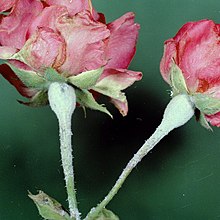Sphaerotheca pannosa
| Podosphaera pannosa | |
|---|---|
 |
|
| Podosphaera pannosa on Rosa sp. | |
| Scientific classification | |
| Kingdom: | Fungi |
| Phylum: | Ascomycota |
| Class: | Leotiomycetes |
| Subclass: | Leotiomycetidae |
| Order: | Erysiphales |
| Family: | Erysiphaceae |
| Genus: | Podosphaera |
| Species: | P. pannosa |
| Binomial name | |
|
Podosphaera pannosa (Wallr.) de Bary, (1870) |
|
| Synonyms | |
|
Acrosporium leucoconium |
|
Acrosporium leucoconium
Alphitomorpha pannosa
Erysiphe pannosa
Oidium forsythiae
Oidium leucoconium
Sphaerotheca macularis f. rosae
Sphaerotheca pannosa
Sphaerotheca pannosa var. persicae
Sphaerotheca pannosa var. rosae
Sphaerotheca persicae
Sphaerotheca rosae
Podosphaera pannosa is a plant pathogen. It produces a powdery mildew on members of the rose family.
Rose powdery mildew [also known as 'Weeping Mildred'] is caused by the fungus Podosphaera pannosa, a member of the Ascomycete fungi. It infects a wide variety of roses, but especially those grown in dryer climates as the fungus has the rare characteristic that not only does it not need water to germinate and reproduce, it can be inhibited by it.
The disease cycle of rose powdery mildew starts when the sexual spores, ascospores, of the pathogen survive the winter in a structure composed of hyphae called an ascocarp. The specific ascocarp is a chasmothecium, or cleistothecium, and has a circular shape to it. Under the right conditions the chasmothecium will break open to reveal the asci, which are long tube-like structures containing the ascospores. These ascospores are then released and spread by wind, insects, and rain until they land on a susceptible rose for a host and land, attach, and germinate on the plant. They will also produce condia, the asexual spores of Podosphaera pannosa, which will spread throughout the summer. It is these long chains of white conidia which give the fungus its characteristic “powdery” appearance. Late in the year as the plant is dying cleistothecia will again form when the ascogonium receives the nucleus from the antheridium.
Optimal conditions for rose powdery mildew are 16-27 degrees Celsius, with the optimal temperature for fungal growth at 23 degrees Celsius in a shaded area. They also do not need water to germinate and infect the rose. In fact, if there is too much water present on plant surfaces for a prolonged period of time the fungal growth is inhibited and the spores can actually die. Rose powdery mildew can also grow in any conditions where roses can grow and has been found everywhere from China to the United States.
A wide variety of rose species are susceptible to powdery mildew. In light of this it is more practical to discuss the rose varieties that are resistant as opposed to those that are susceptible. Two varieties that have been found to show resistance to rose powdery mildew are "Paul's Pink" rose variety and the "Magic" rose variety. Other research has shown that many chestnut rose (Rosa roxburghii) varieties are also resistant to powdery mildew. Rosa sterilis, Rosa kweichowensis, Rosa laevigata, Rosa lucidissima, and Rosa chinensis have all been shown to be resistant to powdery mildew. R. multiflora var. multiflora and R. multiflora var. cathayensis have all been shown to be susceptible to rose powdery mildew. Symptoms caused by the rose powdery mildew can be a dwarfing of the growth of the plant, or the twisting and deforming of leaves, but more noticeable is a sign of the disease, which is the white condia, the “powder” that appears on the plant surfaces, such as leaves, shoots, flowers, and buds. The fungus may grow on both new and old leaves, but is generally more concentrated on the underside of the leaf
...
Wikipedia
